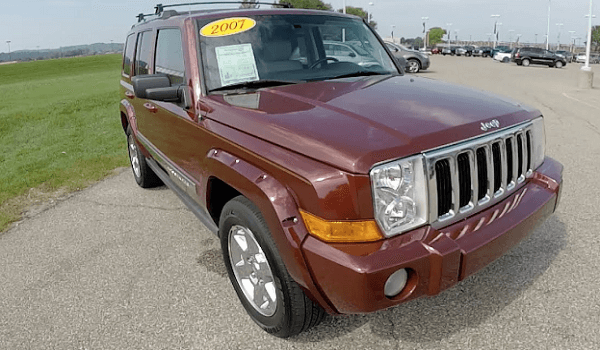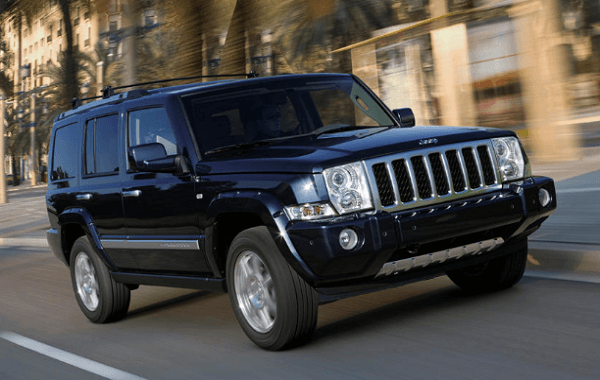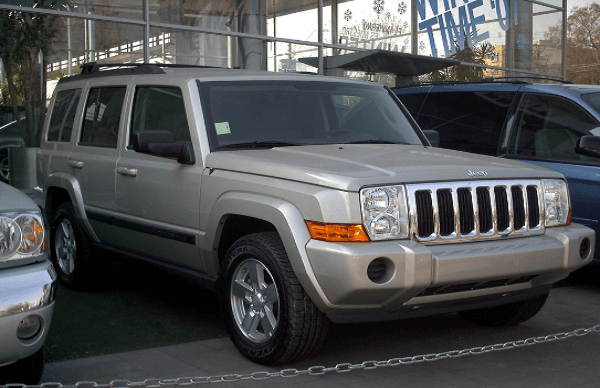Jeep Commander Years to Avoid – The Jeep Commander, a mid-size SUV produced by Jeep from 2005 to 2010, offers a rugged and versatile driving experience for those seeking off-road capabilities and ample space for passengers and cargo. However, like any vehicle, there are certain model years that may have had more issues or problems than others.
In this guide, we will explore the Jeep Commander years to avoid, providing you with important information to make an informed decision when purchasing a used Commander.
It’s important to note that this guide is based on historical data and common issues reported by owners and experts.
While these model years may have higher chances of encountering problems, it does not necessarily mean that every vehicle produced during these years will have issues.
Proper maintenance, care, and individual vehicle history can greatly influence the overall reliability of a particular Commander.
Without further ado, let’s delve into the specific model years that are often considered less desirable when it comes to the Jeep Commander.

Jeep Commander Years to Avoid
When considering a used Jeep Commander as your next vehicle, it’s important to be aware of specific model years that may have had more issues or problems than others.
2006 Jeep Commander
The 2006 Jeep Commander was the first model year for this mid-size SUV, and as with many first-year models, it had its fair share of teething problems. Owners and experts reported issues with electrical components, including faulty door locks, window regulators, and power mirror controls.
Some Commander owners experienced transmission problems, such as rough shifting and occasional failure.
2007 Jeep Commander

The 2007 Jeep Commander addressed some of the issues from the previous year but still had its own set of concerns.
One of the most notable problems reported by owners was related to the Jeep Commander’s fuel system. Some drivers experienced fuel leaks, which posed a safety risk.
The 2007 model year had continued reports of transmission issues, including slipping gears and failure. These problems led to concerns about the Commander’s overall reliability and cost of ownership.
2008 Jeep Commander
The 2008 Jeep Commander saw improvements in certain areas, but there were still recurring issues reported by owners. One significant problem was related to the vehicle’s suspension system.
Some drivers experienced problems with the suspension components, leading to an uncomfortable ride and potential safety hazards.
In addition, electrical problems persisted, with various complaints about malfunctioning power windows and door locks.
2009 Jeep Commander
The 2009 Jeep Commander marked the final year of production for this model, but it still had its fair share of reported issues. One prominent concern was related to the engine.
Several owners reported oil consumption problems, which could lead to engine damage if not addressed promptly.
The 2009 Commander also continued to have electrical issues, including problems with the instrument cluster and various interior components.
Jeep Commander Best Year: 2010
When searching for a used Jeep Commander, it’s essential to identify the best year that combines reliability, performance, and features.
From improved engineering to enhanced safety features, the 2010 Commander offers a compelling choice for those in search of a reliable mid-size SUV.

1. Enhanced Design and Features
The 2010 Jeep Commander boasted several design upgrades and features that set it apart from its predecessors. It featured a refreshed exterior design, providing a more modern and stylish appearance.
Inside the cabin, occupants enjoyed an improved interior with high-quality materials, comfortable seating, and ample space for both passengers and cargo.
The 2010 Commander also introduced advanced technology features, such as an available touchscreen infotainment system, Bluetooth connectivity, and a premium audio system, enhancing the overall driving experience.
2. Reliability Improvements
Jeep made significant efforts to address reliability concerns with the 2010 Commander. Many of the recurring issues reported in earlier model years, such as electrical problems, transmission concerns, and fuel system leaks, were either minimized or resolved in the 2010 version.
By this point, Jeep had fine-tuned the Commander’s components and systems, resulting in a more dependable and trouble-free driving experience for owners.
3. Enhanced Safety Features
Safety is a critical consideration for any vehicle, and the 2010 Jeep Commander offered several enhancements in this area. It came equipped with standard safety features, including antilock brakes, stability control, and multiple airbags.
The 2010 Commander introduced available advanced safety features, such as rear parking sensors and a rearview camera, assisting drivers in maneuvering the vehicle safely.
These improvements further solidified the 2010 Commander’s reputation as a reliable and secure mid-size SUV.
4. Powerful Performance and Off-Road Capability
One of the defining characteristics of the Jeep Commander is its impressive off-road capability. The 2010 model continued this legacy by offering robust engine options and advanced four-wheel-drive systems.
The base engine was a 3.7-liter V6, providing ample power for daily driving needs.
For those seeking even more performance, a 5.7-liter V8 engine was available, delivering increased horsepower and torque.
With Jeep’s renowned 4×4 systems, the 2010 Commander excelled in navigating challenging terrains, making it an excellent choice for outdoor enthusiasts and adventure seekers.
Jeep Commander Problems
The Jeep Commander, known for its ruggedness and versatility, is not without its fair share of common problems.

1. Engine Problems
One of the most commonly reported issues in the Jeep Commander is related to engine performance and reliability. Some owners have experienced engine misfires, excessive oil consumption, and occasional stalling.
These problems can be attributed to various factors, including faulty ignition coils, worn spark plugs, or issues with the engine control module.
Regular maintenance, such as timely oil changes and thorough inspections, can help prevent or address potential engine problems.
2. Braking System Issues
Several Jeep Commander owners have reported problems with the braking system. This includes brake pedal pulsation, premature brake pad wear, and occasional brake failure.
In some cases, these issues may be caused by worn brake rotors, malfunctioning brake calipers, or inadequate brake fluid levels.
Timely brake inspections, proper maintenance, and prompt replacement of worn components can help ensure the braking system’s reliability and safety.
3. Electrical System Malfunctions
Electrical problems are another area of concern in the Jeep Commander. Owners have reported issues such as malfunctioning power windows and door locks, faulty instrument clusters, and sporadic electrical failures.
These problems can often be traced back to loose connections, faulty wiring, or malfunctioning control modules.
Regular inspections and prompt repair of any electrical issues can help maintain the proper functioning of the vehicle’s electrical system.
4. Problems with the Equipment
Some owners have reported issues with various equipment components in the Jeep Commander. These may include problems with the air conditioning system, malfunctioning infotainment systems, and occasional failures of power seats or mirrors.
These equipment-related issues can often be addressed through proper maintenance, regular servicing, and, if necessary, repair or replacement of the affected components.
Jeep Commander Pros and Cons
Like any vehicle, the Jeep Commander has its share of advantages and disadvantages.

Pros of the Jeep Commander
1. Off-Road Capability
One of the standout features of the Jeep Commander is its off-road capability. With Jeep’s renowned 4×4 systems, robust suspension, and high ground clearance, the Commander can tackle challenging terrains with ease.
Whether you’re traversing rocky trails or navigating through snow-covered roads, the Commander’s off-road prowess is a major advantage for adventure enthusiasts.
2. Spacious Interior
The Commander offers a generous interior space, accommodating up to seven passengers across three rows of seating. This makes it an ideal choice for larger families or those who frequently travel with a group of people.
The Commander provides ample cargo space, allowing you to transport belongings, camping gear, or sports equipment with ease.
3. Towing Capability
If you require towing capabilities, the Jeep Commander delivers. With a robust engine lineup and proper towing packages, the Commander can tow a significant amount of weight, making it suitable for hauling trailers, boats, or other heavy loads.
4. Iconic Jeep Styling
The Jeep Commander features the iconic styling that has become synonymous with the Jeep brand. Its rugged and muscular exterior design exudes a sense of adventure and durability, appealing to those who value a distinct and bold appearance.
Cons of the Jeep Commander
1. Fuel Efficiency
The Commander’s larger size and powerful engines contribute to its lower fuel efficiency compared to smaller SUVs or sedans. If you prioritize fuel economy, the Commander may not be the most economical choice, especially for daily commuting or city driving.
2. Limited Maneuverability
Due to its larger dimensions, the Commander may feel less maneuverable in tight spaces or crowded urban areas. Its turning radius and overall handling may not be as nimble as smaller SUVs, making it more challenging to navigate through parking lots or narrow streets.
3. Outdated Technology
While the Commander offers ample space and ruggedness, its technology features may feel outdated compared to newer models. Some older Commanders may lack modern infotainment systems, advanced driver-assistance features, and connectivity options that are now prevalent in more recent vehicles.
4. Reliability Concerns
Although the Commander is generally regarded as a reliable vehicle, certain model years have had reported issues, including engine problems, braking system concerns, and electrical malfunctions.
Conducting thorough research, inspecting a used Commander, and considering individual vehicle history can help mitigate potential reliability concerns.
Jeep Commander Competitors
The mid-size SUV market is highly competitive, offering a wide range of options for buyers seeking a versatile and capable vehicle. Among the contenders, the Jeep Commander stands out with its ruggedness and off-road capabilities.
1. Chevrolet Trailblazer
The Chevrolet Trailblazer, a compact SUV, offers a sporty design and a range of engine options. It provides a comfortable ride and has impressive fuel efficiency, making it suitable for daily commuting. However, the Trailblazer’s off-road capabilities are not as robust as the Commander’s, and its interior may feel smaller and less spacious.
2. Toyota 4Runner
The Toyota 4Runner is renowned for its exceptional off-road performance and reliability. It boasts durable body-on-frame construction and offers advanced off-road systems for tackling challenging terrains.
The 4Runner also provides a spacious interior and a high level of build quality. However, its fuel efficiency is not as impressive, and its technology features may feel outdated compared to some competitors.
3. Nissan Pathfinder
The Nissan Pathfinder offers a comfortable and spacious interior, making it a good choice for families. It provides a smooth ride and has a respectable towing capacity.
The Pathfinder also offers modern technology features and driver-assistance systems. However, its off-road capabilities are not on par with the Commander or 4Runner, and some owners have reported concerns regarding its reliability.
4. Ford Explorer
The Ford Explorer is a popular mid-size SUV known for its comfortable ride and ample cargo space. It offers a range of engine options, including hybrid variants, catering to various needs.
The Explorer also provides advanced safety features and modern technology, such as Ford’s SYNC infotainment system.
However, its off-road capabilities are limited, and some owners have reported issues with reliability and build quality.
5. Honda Pilot
The Honda Pilot is recognized for its spacious and well-designed interior, offering seating for up to eight passengers. It provides a smooth and comfortable ride and delivers respectable fuel efficiency.
The Pilot also offers a range of safety features and advanced driver-assistance systems.
However, its off-road capabilities are not as robust as the Commander or 4Runner, and its exterior design may be less distinctive for those seeking a bolder look.
How Long Do Jeep Commanders Last?
The lifespan of a Jeep Commander can vary depending on several factors, including maintenance, driving conditions, and individual usage. However, with proper care and regular maintenance, a Jeep Commander can last upwards of 200,000 miles or more.
Many owners have reported their Commanders lasting well beyond this mileage mark.
Are Jeep Commanders Good Cars?
As for whether Jeep Commanders are good cars, it ultimately depends on individual preferences and priorities. The Jeep Commander has several qualities that make it a desirable choice for certain buyers. Its ruggedness, off-road capabilities, and spacious interior make it suitable for those who value adventure, versatility, and the ability to tackle challenging terrains.
The Commander’s towing capacity is also noteworthy, making it appealing for those who require the ability to haul heavy loads.
However, it’s important to note that Jeep Commanders have had some reported issues, particularly with certain model years. These issues have included engine problems, braking system concerns, electrical malfunctions, and equipment-related issues.
While not all Commanders will experience these problems, it’s essential to conduct thorough research, inspect any used vehicle before purchase, and consider individual vehicle history to ensure you are getting a well-maintained and reliable vehicle.
The fuel efficiency of Jeep Commanders is generally lower compared to smaller SUVs or sedans.
Maneuverability in tight spaces may also be a consideration, as the Commander’s larger size can make it more challenging to navigate through crowded urban areas.
Conclusion
It is important to note that not all Jeep Commanders from these years will experience these issues, and some owners have had positive experiences with their vehicles. However, the higher prevalence of reported problems in these particular model years suggests that they may be more prone to issues compared to other years.
When considering a used Jeep Commander, it is recommended to focus on model years beyond 2009, such as the 2010 Commander, which has shown improvements in reliability and addressed many of the concerns reported in earlier years.
While the Jeep Commander can offer a rugged and versatile driving experience, it is important to be aware of the reported issues in certain model years and exercise caution when considering a used vehicle from those years.
By doing so, you can increase the likelihood of finding a Jeep Commander that provides a reliable and enjoyable ownership experience.
Find More Articles About Jeep Years To Avoid:
- Jeep Compass Years To Avoid
- Jeep Renegade Years To Avoid
- Jeep Patriot Years To Avoid
- Jeep Liberty Years To Avoid
- Jeep Grand Cherokee Years To Avoid
- Why Are Jeep Renegades So Expensive?
- Why Are Jeep Patriots So Cheap?
- Why Are Jeep Wranglers So Popular?
- Is Jeep Wrangler A Good First Car?
- Is A Jeep Renegade A Good First Car?
- Most Expensive Jeep
- Most Reliable Jeep Models
- Are Jeeps Reliable?